A Spawn Mobile Agent Itinerary Planning Approach for Energy-Efficient Data Gathering in Wireless Sensor Networks
Abstract
:1. Introduction
- Local data processing: the MA can migrate from node to node and do a local processing at the node in order to achieve an assigned task on behalf of the MA’s dispatcher (sink), and then it returns to the sink with the results. This would lead to a decrease in the network’s bandwidth because the nodes no longer need to transmit their data frequently to the sink for data processing.
- Extensibility and task adaptability: Within the same network, several MAs with different assigned tasks can be dispatched to the network. Each MA can be used to carry out a specific task, and then different applications can be achieved. Therefore, the extensibility and task adaptability of MA extends WSNs’ functionality.
- Fault-tolerance: The itinerary of MA can be dynamically determined by the information gain and energy constraints [6]. The MA can check the information of the next hop nodes before it decides to migrate to the next hop. Here, the fault-tolerance such as link failure or dead nodes can be avoided during the MA path and then protect the MA from being lost.
- Progressive accuracy: During the migration, the MA carries a partially integrated result obtained from nodes that have already been visited by the MA. Thus, assuming the MA follows an itinerary determined based on the information gain, the migration from node to node is constantly increasing the accuracy of the integrated result. Therefore, the MA can terminate its migration and returns the results when the accuracy of the integrated result satisfies a given threshold. This advantage of MA decreases both network bandwidth and computation time by avoiding visiting unnecessary nodes.
- Reliability: The MA can be dispatched when the network connection is active and it returns the results when the network connection is re-established. Consequently, the MA’s performance is not affected much by the reliability of the network.
- Architecture
- Itinerary planning
- Middleware system design
- Agent cooperation
- Long delays because of migrating to hundreds of source nodes.
- An increase in the MA’s packet size due to the aggregation of data from a huge number of visited source nodes.
- Low reliability when the MA accumulates a huge amount of data.
- The probability of losing the MA’s packet increases when a single MA visits many source nodes.
- Determining the optimal number of MAs.
- Partitioning the source nodes into subsets of groups and assigning each MA to a specific group.
- Finding the optimal itinerary of each MA.
2. Related Work
3. Spawn Multi-Mobile Agent Itinerary Planning (SMIP) Approach
3.1. Partitioning the Network
3.2. Spawn Mobile Agent (SMA) Algorithm in SMIP
- MA ID: is the identification number of each MA dispatched by the sink node.
- MA Itinerary: contains the itinerary information (source nodes’ visited order list) assigned by the sink node when dispatched.
- Data payload: MA’s data buffer which carries the aggregation data results.
- SMA code: is the code of the spawning carried by MA.
- SMA Packet: includes the SMA ID, the itinerary information of the SMA (visited sensor nodes) to get back to the sink node, and SMA payload data. Note that the MA could carry more than one SMA.
- Data aggregation code: is the implementation of the data aggregation algorithm.
3.3. Determining the Itinerary for Each MA in SMIP
| Algorithm 1: Pseudo-code of SMIP approach. |
 |
3.4. SMA Itinerary Energy Calculation
4. Simulation Setup
5. Performance Evaluation
6. Conclusions
Acknowledgments
Author Contributions
Conflicts of Interest
References
- Romer, K.; Mattern, F. The design space of wireless sensor networks. IEEE Wirel. Commun. 2004, 11, 54–61. [Google Scholar] [CrossRef]
- Cheng, Z.; Perillo, M.; Heinzelman, W.B. General network lifetime and cost models for evaluating sensor network deployment strategies. IEEE Trans. Mobile Comput. 2008, 7, 484–497. [Google Scholar] [CrossRef]
- Yan, J.; Zhou, M.; Ding, Z. Recent advances in energy-efficient routing protocols for wireless sensor networks: A review. IEEE Access 2016, 4, 5673–5686. [Google Scholar] [CrossRef]
- Qi, H.; Wang, F. Optimal itinerary analysis for mobile agents in ad hoc wireless sensor networks. Proc. IEEE 2001, 1, 147–153. [Google Scholar]
- Chen, M.; Kwon, T.; Yuan, Y.; Choi, Y.; Leung, V. Mobile agent-based directed diffusion in wireless sensor networks. EURASIP J. Appl. Signal Process. 2007, 2007, 219. [Google Scholar] [CrossRef]
- Wu, Q.; Rao, N.S.; Barhen, J.; Iyenger, S.; Vaishnavi, V.K.; Qi, H.; Chakrabarty, K. On computing mobile agent routes for data fusion in distributed sensor networks. IEEE Trans. Knowl. Data Eng. 2004, 16, 740–753. [Google Scholar] [CrossRef]
- Gan, L.; Liu, J.; Jin, X. Agent-based, energy efficient routing in sensor networks. In Proceedings of the Third International Joint Conference on Autonomous Agents and Multiagent Systems-Volume 1. IEEE Computer Society, Washington, DC, USA, 19–23 July 2004; pp. 472–479. [Google Scholar]
- Chen, M.; Kwon, T.; Yuan, Y.; Leung, V. Mobile agent based wireless sensor networks. J. Comput. 2006, 1, 14–21. [Google Scholar] [CrossRef]
- Qi, H.; Wang, X.; Iyengar, S.S.; Chakrabarty, K. Multisensor data fusion in distributed sensor networks using mobile agents. In Proceedings of the 5th International Conference on Information Fusion, Annapolis, MD, USA, 8–11 July 2001; pp. 11–16. [Google Scholar]
- Yuan, L.; Wang, X.; Gan, J.; Zhao, Y. A data gathering algorithm based on mobile agent and emergent event-driven in cluster-based WSN. J. Netw. 2010, 5, 1160–1168. [Google Scholar] [CrossRef]
- Wang, X.; Chen, M.; Kwon, T.; Chao, H.C. Multiple mobile agents’ itinerary planning in wireless sensor networks: Survey and evaluation. IET Commun. 2011, 5, 1769–1776. [Google Scholar] [CrossRef]
- Qi, H.; Xu, Y.; Wang, X. Mobile-agent-based collaborative signal and information processing in sensor networks. Proc. IEEE 2003, 91, 1172–1183. [Google Scholar]
- Chen, M.; Gonzalez, S.; Leung, V. Applications and design issues for mobile agents in wireless sensor networks. IEEE Wirel. Commun. 2007, 14, 20–26. [Google Scholar] [CrossRef]
- Qadori, H.Q.; Zulkarnain, Z.A.; Hanapi, Z.M.; Subramaniam, S. Multi-mobile agent itinerary planning algorithms for data gathering in wireless sensor networks: A review paper. Int. J. Distrib. Sens. Netw. 2017, 13. [Google Scholar] [CrossRef]
- Chen, M.; Leung, V.; Mao, S.; Kwon, T.; Li, M. Energy-efficient itinerary planning for mobile agents in wireless sensor networks. In Proceedings of the IEEE International Conference on Communications, 2009 (ICC’09), Dresden, Germany, 14–18 June 2009; pp. 1–5. [Google Scholar]
- Chen, M.; Gonzalez, S.; Zhang, Y.; Leung, V.C. Multi-agent itinerary planning for wireless sensor networks. In International Conference on Heterogeneous Networking for Quality, Reliability, Security and Robustness; Springer: Berlin/Heidelberg, Germany, 2009; pp. 584–597. [Google Scholar]
- Cai, W.; Chen, M.; Hara, T.; Shu, L.; Kwon, T. A genetic algorithm approach to multi-agent itinerary planning in wireless sensor networks. Mobile Netw. Appl. 2011, 16, 782–793. [Google Scholar] [CrossRef]
- Bendjima, M.; Feham, M. Multi mobile agent itinerary for wireless sensor networks. Int. J. Emerg. Trends Technol. Comput. Sci. 2012, 1, 6–11. [Google Scholar]
- Aloui, I.; Kazar, O.; Kahloul, L.; Servigne, S. A new Itinerary planning approach among multiple mobile agents in wireless sensor networks (WSN) to reduce energy consumption. Int. J. Commun. Netw. Inf. Secur. 2015, 7, 116. [Google Scholar]
- Wang, J.; Zhang, Y.; Cheng, Z.; Zhu, X. EMIP: Energy-efficient itinerary planning for multiple mobile agents in wireless sensor network. Telecommun. Syst. 2015, 62, 93–100. [Google Scholar] [CrossRef]
- Mpitziopoulos, A.; Gavalas, D.; Konstantopoulos, C.; Pantziou, G. Deriving efficient mobile agent routes in wireless sensor networks with NOID algorithm. In Proceedings of the IEEE 18th International Symposium on Personal, Indoor and Mobile Radio Communications, 2007. PIMRC 2007, Athens, Greece, 3–7 September 2007; pp. 1–5. [Google Scholar]
- Gavalas, D.; Venetis, I.E.; Konstantopoulos, C.; Pantziou, G. Mobile agent itinerary planning for WSN data fusion: considering multiple sinks and heterogeneous networks. Int. J. Commun. Syst. 2016, 30, e3184. [Google Scholar] [CrossRef]
- Gavalas, D.; Pantziou, G.; Konstantopoulos, C.; Mamalis, B. New techniques for incremental data fusion in distributed sensor networks. In Proceedings of the 11th Panhellenic Conference on Informatics (PCI 2007), Patras, Greece, 18–20 May 2007; pp. 599–608. [Google Scholar]
- Gavalas, D.; Venetis, I.E.; Konstantopoulos, C.; Pantziou, G. Energy-efficient multiple itinerary planning for mobile agents-based data aggregation in WSNs. Telecommun. Syst. 2016, 63, 531–545. [Google Scholar] [CrossRef]
- Pelleg, D.; Moore, A. Accelerating exact k-means algorithms with geometric reasoning. In Proceedings of the fifth ACM SIGKDD International Conference on Knowledge Discovery and Data Mining, New York, NY, USA, 15–18 August 1999; pp. 277–281. [Google Scholar]
- Alshaki, O.T.; Ahmad, M.S. A conceptual framework for agent spawning. In Proceedings of the 2014 IEEE International Conference on Computational Science and Technology (ICCST), Kota Kinabalu, Malaysia, 27–28 August 2014; pp. 1–5. [Google Scholar]
- Chen, M.; Yang, L.T.; Kwon, T.; Zhou, L.; Jo, M. Itinerary planning for energy-efficient agent communications in wireless sensor networks. IEEE Trans. Veh. Technol. 2011, 60, 3290–3299. [Google Scholar] [CrossRef]
- Akyildiz, I.F.; Melodia, T.; Chowdhury, K.R. A survey on wireless multimedia sensor networks. Comput. Netw. 2007, 51, 921–960. [Google Scholar] [CrossRef]
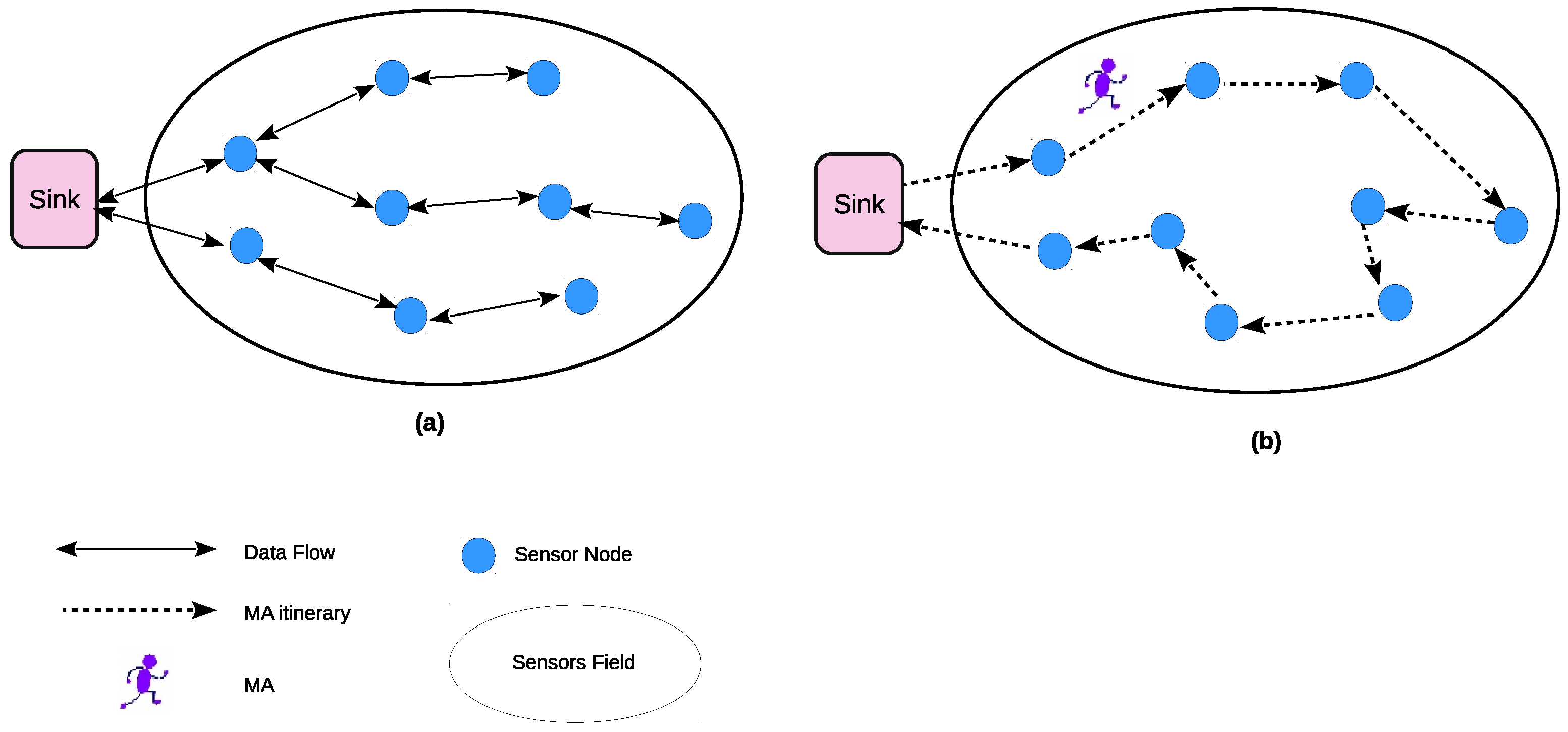

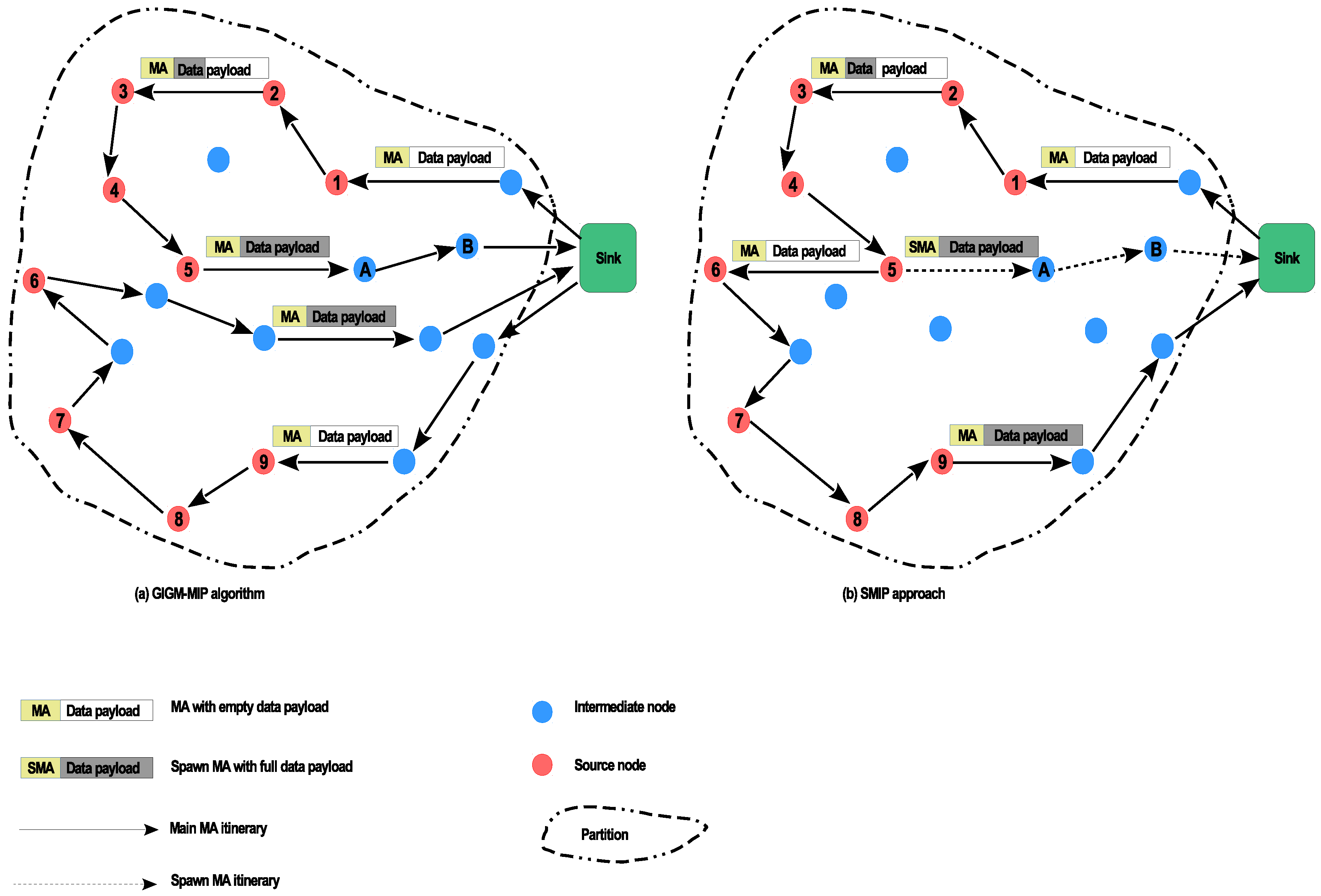
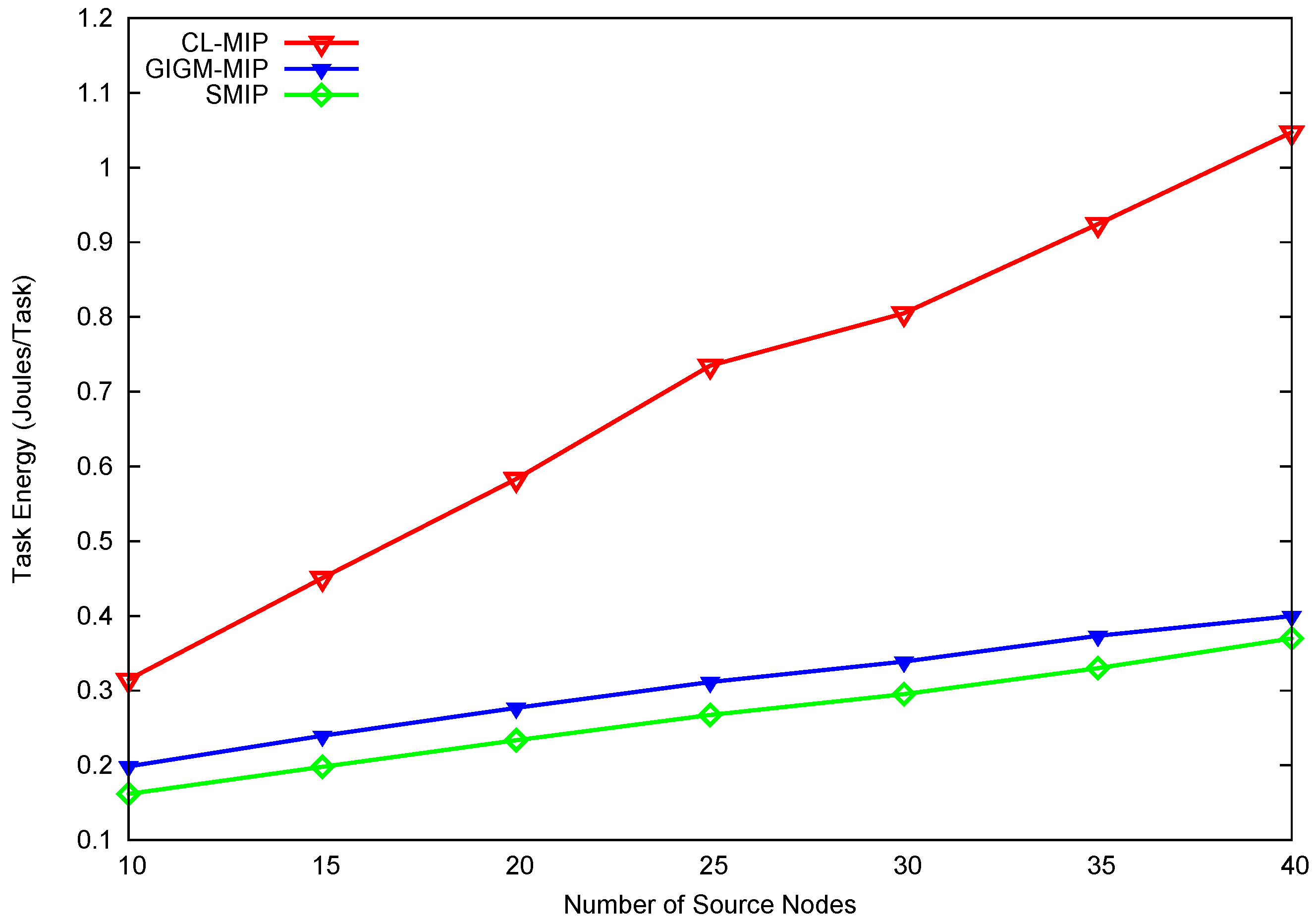
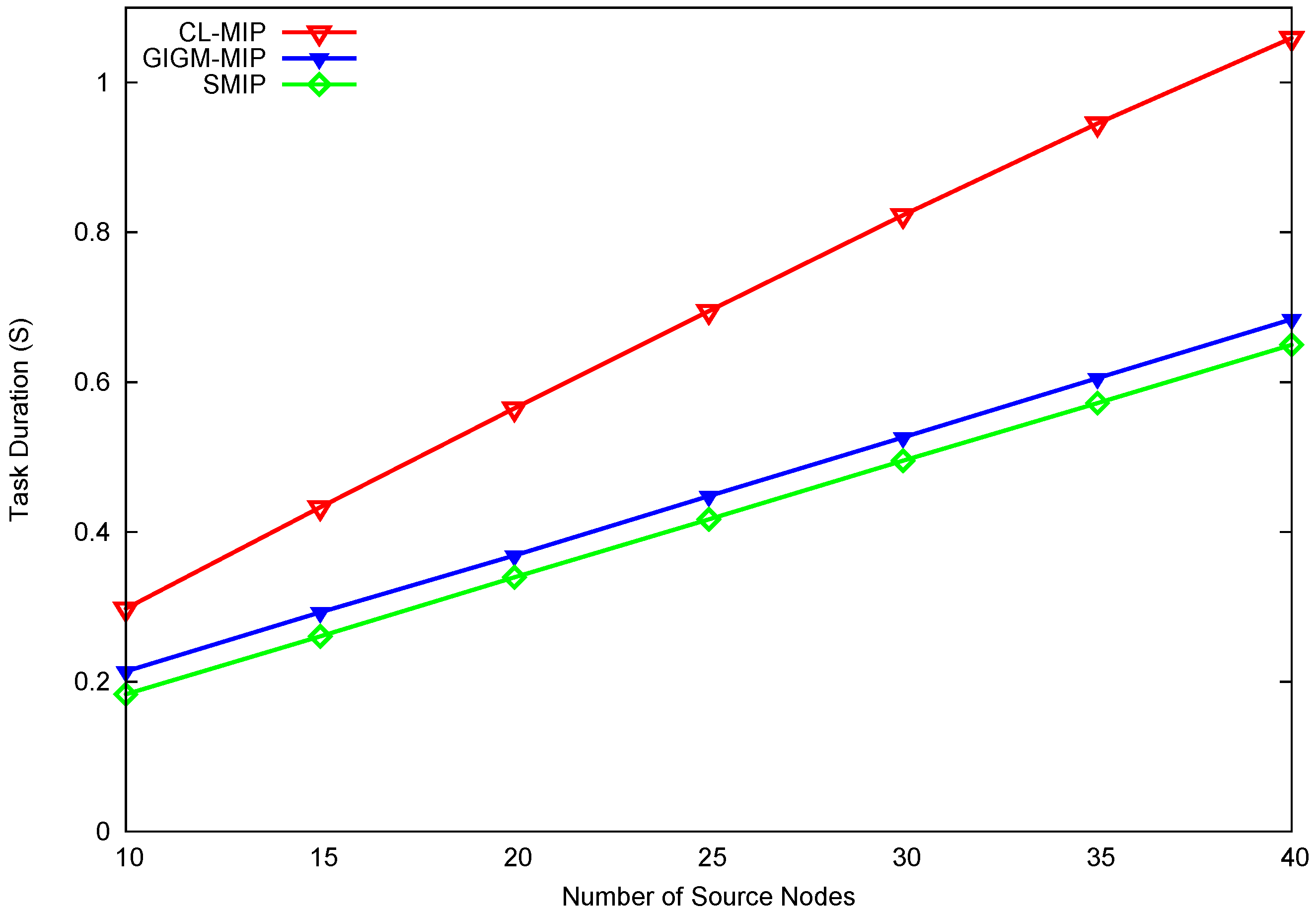
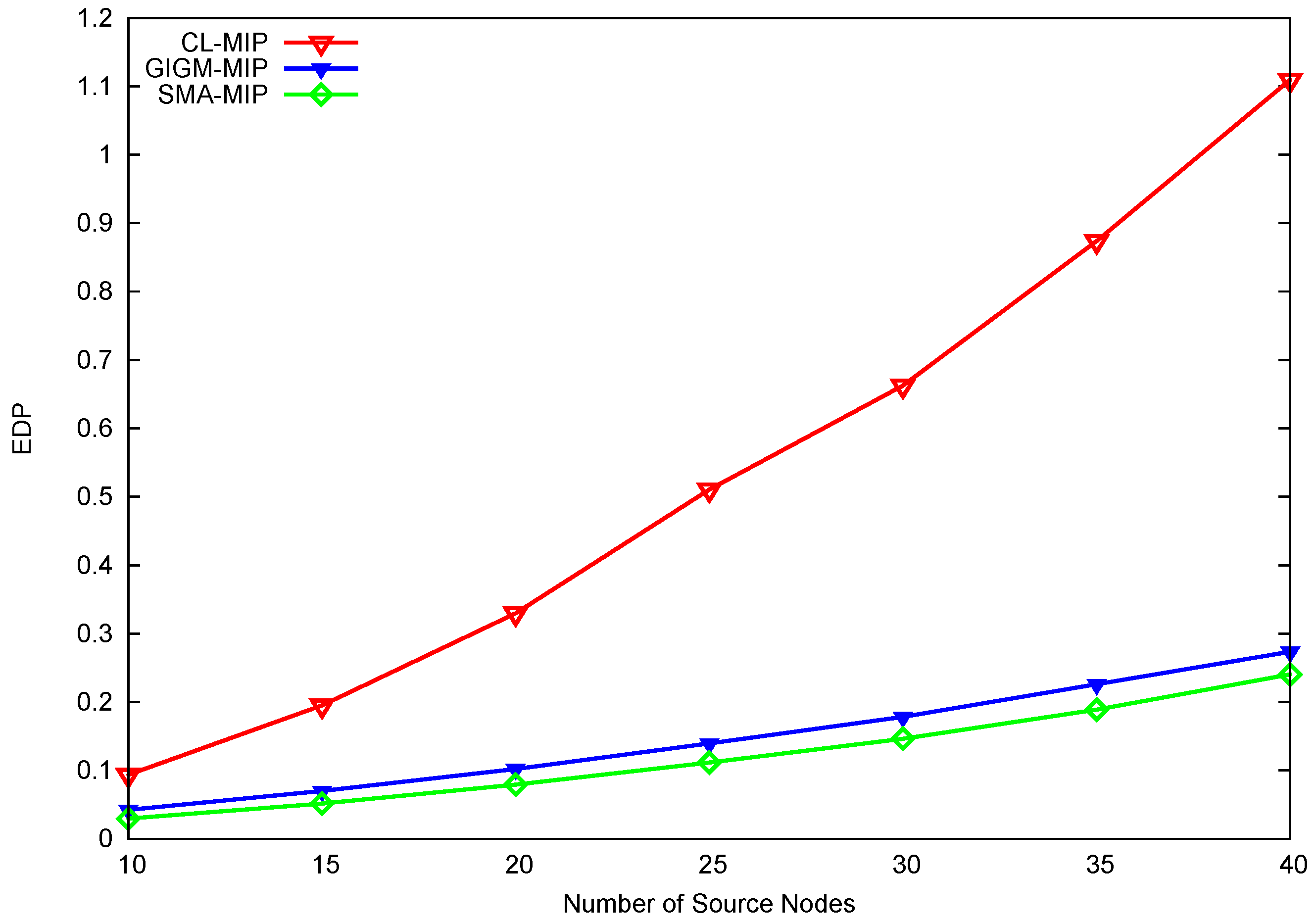
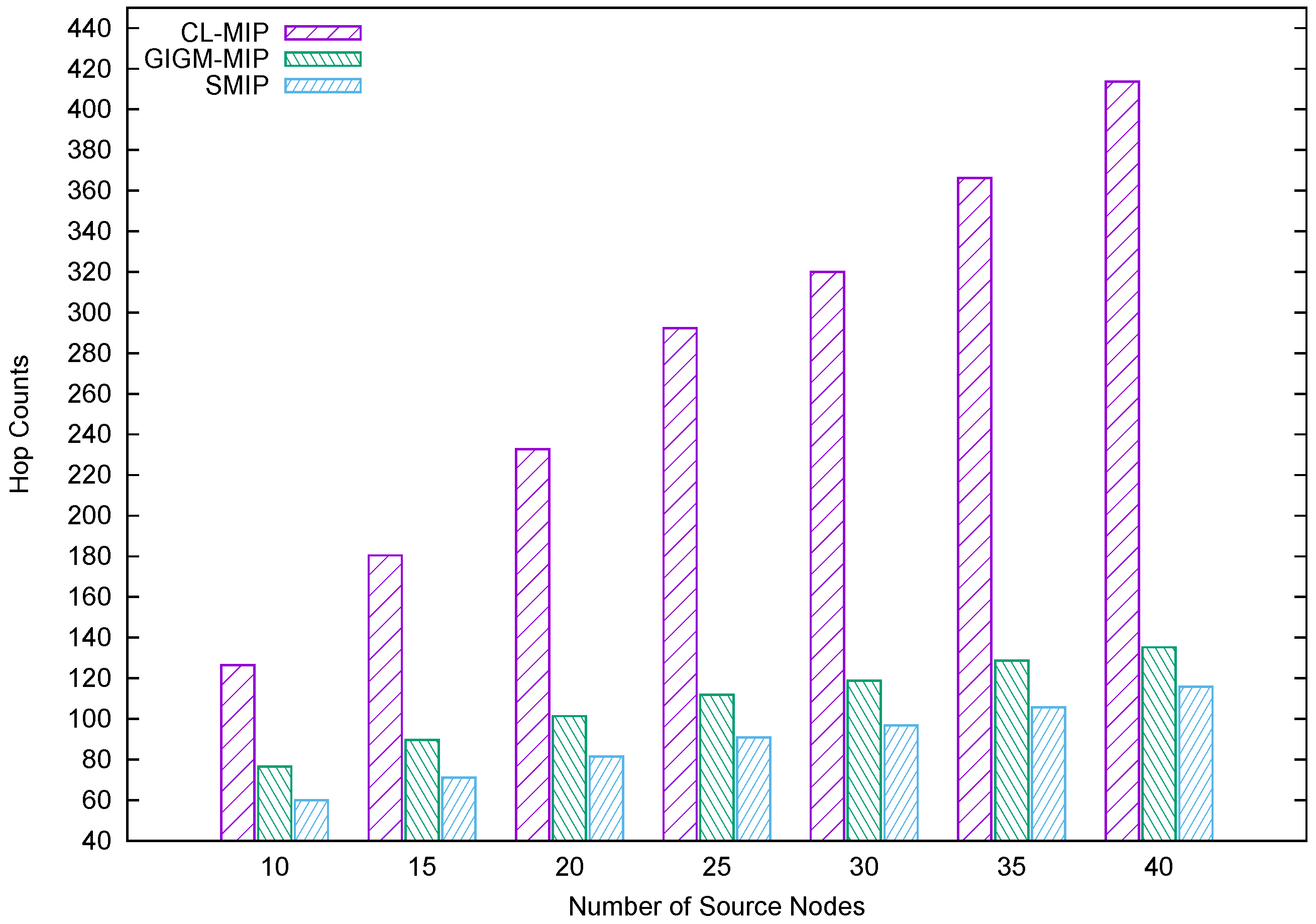

| Network Parameters | Value |
| Network’s Terrain | 1000 m × 500 m |
| Number of deployed nodes | 800 |
| Number of source nodes | 10–40 |
| Transmission range | 60 m |
| Raw data size | 1024 bits |
| MA Parameters | Value |
| MA processing code | 1024 bits |
| MA accessing delay | 10 ms |
| Raw data reduction ratio | 0.8 |
| Aggregation ratio | 0.9 |
| Data processing rate | 50 Mbps |
| Data payload threshold | 1500 bits |
| SMA Parameters | Value |
| SMA processing code | 128 bits |
| SMA accessing delay | 10 ms |
| Data processing rate | 50 Mbps |
© 2017 by the authors. Licensee MDPI, Basel, Switzerland. This article is an open access article distributed under the terms and conditions of the Creative Commons Attribution (CC BY) license (http://creativecommons.org/licenses/by/4.0/).
Share and Cite
Qadori, H.Q.; Zulkarnain, Z.A.; Hanapi, Z.M.; Subramaniam, S. A Spawn Mobile Agent Itinerary Planning Approach for Energy-Efficient Data Gathering in Wireless Sensor Networks. Sensors 2017, 17, 1280. https://doi.org/10.3390/s17061280
Qadori HQ, Zulkarnain ZA, Hanapi ZM, Subramaniam S. A Spawn Mobile Agent Itinerary Planning Approach for Energy-Efficient Data Gathering in Wireless Sensor Networks. Sensors. 2017; 17(6):1280. https://doi.org/10.3390/s17061280
Chicago/Turabian StyleQadori, Huthiafa Q., Zuriati A. Zulkarnain, Zurina Mohd Hanapi, and Shamala Subramaniam. 2017. "A Spawn Mobile Agent Itinerary Planning Approach for Energy-Efficient Data Gathering in Wireless Sensor Networks" Sensors 17, no. 6: 1280. https://doi.org/10.3390/s17061280






